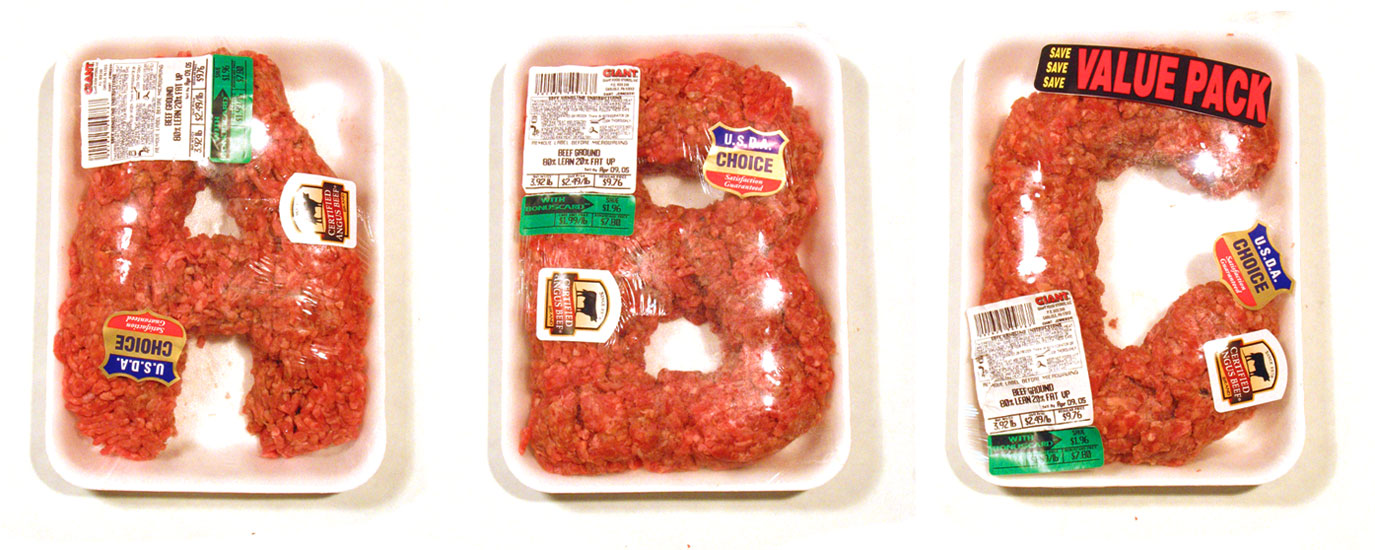25 Jul 2007
Moving on from Blogger
15 Jul 2007
For the love of what?
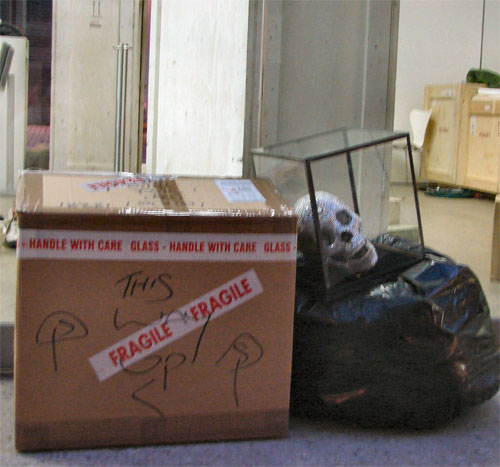 The "For the Love of God" prank was created using 6522 Swarovski crystals
The "For the Love of God" prank was created using 6522 Swarovski crystalsand took Laura, the artist, a month to create. Link.
1 Jul 2007
Busyness Economy v Burst Economy
The busyness economy works on face time, incremental improvement, strategic long-term planning, return on investment, and hierarchical control. The burst economy, enabled by the Web, works on innovation, flat knowledge networks, and discontinuous productivity:
Harvard Business School professor Andrew McAfee identifies the culture clash between these two economies:
We’ve spent the past couple weeks in my MBA class discussing E2.0 technologies (including blogs, wikis, and prediction markets), approaches, and initiatives. One of the most interesting things for me about these classes has been how often students bring up one specific concern: that people who use the new tools heavily — who post frequently to an internal blog, edit the corporate wiki a lot, or trade heavily in the internal prediction market — will be perceived as not spending enough time on their ‘real’ jobs.
2 Jun 2007
30 May 2007
melted keyboard

A couple years ago, someone (allegedly, they were never caught) set fire to a lumber mill in 100 Mile House, BC, Canada. Definitely was not a nice occurrence, but at least the heat from the fire created this wonderful keyboard sculpture, which I've photographed in tiny detail. Because someone will surely ask, the keyboard is from an older HP. Vectra, I think.
27 May 2007
screwed
 Screw Asylum, the home of sad and bad screws on the Internet.
Screw Asylum, the home of sad and bad screws on the Internet.Well, someone’s got to look after them.
Apparently...
running the numbers

Detail of
Shipping Containers, 2007
60x100"
Depicts 75,000 shipping containers, the number of containers processed through American ports every day.
Running the numbers: An American Self-Portrait
This new series looks at contemporary American culture through the austere lens of statistics. Each image portrays a specific quantity of something: fifteen million sheets of office paper (five minutes of paper use); 106,000 aluminum cans (thirty seconds of can consumption) and so on. My hope is that images representing these quantities might have a different effect than the raw numbers alone, such as we find daily in articles and books. Statistics can feel abstract and anesthetizing, making it difficult to connect with and make meaning of 3.6 million SUV sales in one year, for example, or 2.3 million Americans in prison, or 426,000 cell phones retired every day. This project visually examines these vast and bizarre measures of our society, in large intricately detailed prints assembled from thousands of smaller photographs.
~chris jordan, Seattle, 2007
(Thanks to Heather for the link, good work!)
wifi evils of bad sience
 “Ooh its well into the red there,” says reporter Paul Kenyon, holding up the detector (19 minutes in). Gosh that sounds bad. Well into the red on what? It’s tricky to callibrate measurements, and to decide what to measure, and what the cut off point is for “red”. Panorama’s readings were “well into the red” on “The COM Monitor”, a special piece of detecting equipment designed from scratch and built by none other than Alasdair Philips of Powerwatch, the man who leads the campaign against WiFi. His bespoke device is manufactured exclusively for Powerwatch, and he will sell one to you for just £175. Alasdair decided what “red” meant on Panorama’s device. So not very independent then.
“Ooh its well into the red there,” says reporter Paul Kenyon, holding up the detector (19 minutes in). Gosh that sounds bad. Well into the red on what? It’s tricky to callibrate measurements, and to decide what to measure, and what the cut off point is for “red”. Panorama’s readings were “well into the red” on “The COM Monitor”, a special piece of detecting equipment designed from scratch and built by none other than Alasdair Philips of Powerwatch, the man who leads the campaign against WiFi. His bespoke device is manufactured exclusively for Powerwatch, and he will sell one to you for just £175. Alasdair decided what “red” meant on Panorama’s device. So not very independent then.Last week's Panorama was on the ''danger" of wifi networks in schools. I missed the show but caught a preview of it on Radio 2 while I was out in the van. It bore no relation to the excellent BBC science reporting of my youth. I grew up on a steady diet of 'Tomorrow's World' and 'Horizon' but these days there is no 'Tomorrow's World' and 'Horizon' has been dumbed down beyond recognition. 'Panorama' used to be the Beeb's flagship current affairs strand but last week it indulged in bad science. I resisted the temptation to don my tinfoil hat and throw popcorn at the screen.
Let's get some perspective here people, the maximum legal output of a 2.4 wifi card in the UK is 100 mW. Your mobile phone can put out a legal maximum of 2W.
8 May 2007
wooden mac

"I am very interested in the far reaching power of nature. We build houses and think that we have controlled space, yet nature winds its way into those materials." Lee Stoetzel
15 Apr 2007
bamboo laptop
 The EcoBook, by Asus, is due to launch next year according to C|net. I wouldn't say no to one of these... My old Asus Terminator may not have been pretty, but it was compact, well made and cheap as chips, it did the job.
The EcoBook, by Asus, is due to launch next year according to C|net. I wouldn't say no to one of these... My old Asus Terminator may not have been pretty, but it was compact, well made and cheap as chips, it did the job.
pottery podcast
 Those nice People at the V&A have put out a series of podcasts about pots. They have taken 10 pots from their collection and asked a selection of curators, makers and academics to talk about each pot. Speaking as a pottery geek, I thought it was so cool to hear Alison Britton talk about the making of her 'Big White Jug' , I have always been a bit of a fan girl of her work...
Those nice People at the V&A have put out a series of podcasts about pots. They have taken 10 pots from their collection and asked a selection of curators, makers and academics to talk about each pot. Speaking as a pottery geek, I thought it was so cool to hear Alison Britton talk about the making of her 'Big White Jug' , I have always been a bit of a fan girl of her work...
4 Apr 2007
3 Apr 2007
29 Mar 2007
2020 vision
From The Fischbowl (a staff development blog for Arapahoe High School), Karl Fisch explains...
As I write this, I realize that I've created a trilogy of sorts. The "What If" presentation was a look at the past, at the resistance to change in education. The "Did You Know" presentation was mainly a look at our present, at the incredible changes that are happening due to "flat world" factors and technological change (with a dash of prediction thrown in). And now "2020 Vision" is a look "back" at our future from the year 2020. (Ummm, yeah, sure, I planned to create a trilogy. That's my story and I'm sticking to it.) Maybe by having one possible version of the future to consider we can get past the natural resistance to change. If nothing else, I hope it's another example of David Warlick's "telling the new story" to get those conversations started.
25 Mar 2007
"We are half a step away from a police state"
 I have a grim facination with Russia, so this caught my eye today because it seemed just so *upbeat and jolly* in it's observation about being a whole half a step away.
I have a grim facination with Russia, so this caught my eye today because it seemed just so *upbeat and jolly* in it's observation about being a whole half a step away.We have a dictatorship in Russia, we know it's been heading there for a while but banning an opposition party on the basis that there are too few members really seems to have tipped over yet another edge.
Earlier this week I caught an interview on Womans Hour on Radio 4 with the sister of the murdered Russian journalist, Anna Politkovskaya. Her last book has just been published posthumously, The Guardian has a few extracts, 'Fascism is in fashion' makes a really chilling read.
14 Mar 2007
4 Mar 2007
bee afraid

The NY Times has a pretty ominous story about vanishing bees:
This winter, in more than 20 states, beekeepers have noticed that their honeybees have mysteriously vanished, leaving behind no clues as to their whereabouts. There are no tell-tale dead bodies either inside colonies or out in front of hives, where bees typically deposit corpses of dead nestmates.
What’s more, the afflicted colonies tend to be full of honey, pollen and larvae, as if all of the workers in the nest precipitously decamped on some prearranged signal. Beekeepers are up in arms — last month, leaders in the business met with research scientists and government officials in Florida to figure out why the bees are disappearing and how to stop the losses. Nobody had any answers.
Back in the early 90s, I remember hearing mutterings about problems with the UK bee populations, I remember virus infections being suggested, but it kind of dropped from the edges of the news just as quickly as it came in. It looks like the *crisis* has been quietly going on for some 30 years over here. There is more on this on the Bumblebee Conservation Trust website as well as some really pretty bee pics in the gallery.
2 Mar 2007
boot sale treasure

I found treasure at the local boot sale in the form of four copies of a magazine called 'Practical Television'. They were from the early 50's, 1950-1954. Sadly the cover was busted on the first one but the contents were intact.
The first edition was published in April 1950 and in the editorial at the front in concluded with:
"Although paper for periodicals became de-rationed as from March 1st, production problems still make it difficult to ensure supplies."
There is an article on page 21 entitled, Building the "Viewmaster": An Amateur Describes his Experiences in Building this Popular Home-constructor Set.
In most of us is the desire to create, to see something grow under our hands, and be able to say, possibly with ill-concealed yet justifiable pride, "I built that".
...
Those of us who grew up with the century were fortunate in being on the "ground floor". It was radio in the early stages. We quickly mastered the simple principles and construction of the crystal set, and quite naturally graduated to the one, two and multi-valve straight sets. But as radio became more of an exact science, and the building of successful receivers required technical ability and expensive calibrating instruments, many erstwhile enthusiasts found the going too difficult and reluctantly downed tools.
I was one of them.
As a spectator I watched the march of the industry, growing more than ever concious of my limitations with the event of television.
The old enthusiasm gripped me. I couldn't afford a television receiver; could I build one? One glance at the chassis almost frightened me and quickly dispelled the forlorn hope I entertained of becoming an early "viewer".
...
And so to Radiolympia 1949.
I must confess that when I saw the "Viewmaster" Envelope on the T.C.C. Stand, I imagined it to be directed to the more advanced amateur. Only by chance did I catch a glimpse of the full-sized wiring diagrams. Here was something I did understand. Moreover, the sound and vision reproduction on the demonstration receiver was of a very high standard..
A close and more leisurely examination later of the contents of the envelope so impressed me with the extreme simplicity of construction that I decided to build the "Viewmaster".
Some friends to whom I shared the charts and conveyed my intentions were sceptical. "It looks too simple, " they said. "There must be some snags somewhere."
These remarks gave me an idea. "Why not make notes as I build the receiver?" I thought. "There may be little points on which my experience will help others. If there are snags, I shal find them. If there are no snags, then many hesitant ones will be encouraged to commence building the 'Viewmaster' and ultimately enjoy the thrill of proudly saying, 'Yes, I built it.'"
And so he begins a series of articles on the building of the "Viewmaster". It's not actually a kit, it's a set of instructions comprising 8 full sized drawings and a 32 page booklet, sponsored by 8 British component manufacturers. Adverts for components "specified for the Viewmaster" litter the magazine.
"Telenews" the news section at the back of the magazine, estimate that at the time of writing:
There are approximately 285,500 television receivers in use at the present time and as the B.B.C. estimates that at least four people look at each receiver the total number of viewers is reasonably accurately estimated to be 1,142,000.
We are assured that production was catching up with demand.
In this context, things like the Homebrew Computer Club in 1970s in Silicon Valley fit right into this kind of technological continuum (though they probably had better teeth in the HCC...)
I have a couple of scans from the magazines on my flickr pages for your enjoyment, they really are quite... something. More when I get the chance.
Kiwi wireless hero

Why pay $20,000 for a commercial link to run your television station when a $10 kitchen wok from the Warehouse is just as effective?
This is exactly how North Otago's newest television station 45 South is transmitting its signal from its studio to the top of Cape Wanbrow, in a bid to keep costs down.
45 South volunteer Ken Jones designed the wok transmitter in his spare time last year when he wanted to provide wireless broadband to his Ardgowan home.
"A group of us wanted to connect our computers to each other and then we worked out a way to get of getting the signal between two points," he said.
He discovered satellite dishes were between $100 to $400 retail and that smaller dishes, the same size as a wok, were $80.
Mr Jones thought he could do better.
Along with friend Murray Bobbette they worked out mathematical equations to prove the curved metal face of a wok would have the same effect as a small satellite dish.
"We have spent a lot of time getting it right -- the first time we installed one we had it up a pole with the handle still on the end of the wok," he said.
"We had it connected to the woolshed and initially you couldn't get a signal the width of the paddock and now it can reach up to 20km."
When the television station 45 South (UHF channel 41) started up in September last year, Mr Jones thought the same technique could be applied.
"The $20,000 for a commercial link was just money we didn't have, so we bought several woks from The Warehouse instead which was convenient and cheap," he said.
Pre-recorded clips at the studio are fed through a computer and beamed to Cape Wanbrow where they are relayed off to television sets around North Otago.
The classic case of Kiwi ingenuity has made its way onto the internet and the technique has been posted by an American website, Mr Jones said.
"People wanted to know all the details about how to make their own, so it is now all publicly documented," he said.
One of the issues they had to deal with was making the pole that the wok sits on high enough to clear the Kingsgate Brydone Hotel.
They needed a clear path from the station to the hill, so the only way was up, building the pole more than eight metres high.
Mr Jones said one wok was providing Oamaru with the signal at present and there was no need to provide another wok for some time
- OAMARU MAIL
For more asian cookware wireless tips checkout this.
24 Feb 2007
Medieval Islamic Mosaics Used Modern Math
 This weeks 'scientists labouring under assumptions of superiority' story comes to us courtesy of live science.com
This weeks 'scientists labouring under assumptions of superiority' story comes to us courtesy of live science.comThe inlaid patterned tiles grace the walls of many structures worldwide, in patterns of mind-boggling intricacy called "girih." Historians have always assumed that medieval architects meticulously developed the patterns with basic tools....
Most mosaic tile walls in medieval Islamic buildings are based on a polygon and star pattern, with lines atop them creating a zip-zag look [image]. Since polygons don't fit together properly without near-perfect symmetry, it would have been very challenging to make the patterns look right, historians say, but they assumed a basic straight-edge and compass were used to get the job done.
Ok, look again at those dazzling tile murals and imagine some potter struggling away with ruler and compass. Not a convincing argument to start with. Why are scholars surprised to find what seems to amount to a 13th Century pattern book being used across the region? It would be nice to read something about ancient ceramics in the press, just the once, that didn't demonstrate how removed from the process of making the 'experts' have become.
Cobalt, the mineral usually used for the blue in glazes in ceramics is pretty tricky to work with, a little goes a really long way, and only when it's fired does it look blue. Now if they were to find the test tiles and the glaze recipes that were also probably doing the rounds with the patterns...
that would be wonderful, but they are probably not looking for that...
17 Feb 2007
ok, just one more manifesto....
a sucker for a manifesto
1644, from It. manifesto "public declaration explaining past actions and announcing the motive for forthcoming ones," originally "proof," from L. manifestus (see manifest).
 I found this manifesto strangely appealing. Nothing to do with me being a typography whore... obviously.
I found this manifesto strangely appealing. Nothing to do with me being a typography whore... obviously.
16 Feb 2007
why make stuff?
You can change the world with a pencil, a piece of paper, a chunk of
charcoal and piece of cardboard, a paintbrush, a crayon, a d-cam, a
blog, a cell phone, a recorder; a projector, some clay and a kiln, some
wood and a few tools, some sticks, stones, and grasses, a stove and
some vegetables, found glass, paper, metal, plastic, a torch, a welder,
a stick and some sand, a knife to carve with, an idea, some mud and
hay, a computer, some seeds, a needle and thread and scrap of fabric,
the list goes on. You can change yourself by using any of this stuff or
any thing else that might come to mind and hand.
Why we make stuff matters. How we make stuff is secondary. Any method,
material or vehicle that allows you to get to what you're trying to
see/feel/say/suggest is equally valid. What we make is not the point.
That we make, that we DO, is.
Making stuff develops the ability to see, hear, taste, smell and feel.
Making stuff is about problem solving, the openness to possibilities,
development of skills, internal and external navigation and resolution,
a sense of exploration and adventure. Making stuff transforms one from
a consumer to a contributor. Making stuff is not passive. Making stuff
involves making choices. Realizing you have choices and making them is
empowering. Empowerment leads to confidence, and the courage to
question and challenge the status quo. Making stuff and sharing it is a
social and political act, which opens avenues for communication. That
can help prevent us from becoming mindless drones subservient to the
mass media, politicians, advertisers and commercial interests that have
constructed the consumer culture for the purposes of distracting and
desensitizing us from reality.
Make it up, make do, make it real, make it personal, make it public.
Make it work, make it accessible, make it cheap, make it fun, make it
serious. Make it loud or soft, make it bright or dim, make it big or
small. Make it obvious, make it subtle, make it to be touched, tasted,
smelled, heard. Make it open to interpretation, open for discussion,
open to criticism. Make it open. Make it from found stuff, made stuff,
recycled, reused and repaired stuff. Make it from scratch, from a kit,
a mix, a box. Make it new or make it old. Make it specific, make it
general, make it purposeful, make it pointless. Make it a question,
make it an answer, make it clear, make it vague. Make it high tech,
make it lo-fi, make it inclusive.
Just make it. When you're done, make more and make different. No need
to explain, justify, apologize, or validate. Make it, and let it go.
Dare to fail big, and attempt to change the world. Resist conformity,
think for yourself and go make some stuff of your very own.
29 Jan 2007
dopa ii
There are laws, and there are hasty-rushed-and-bad-laws (Any legislation that gets brought in on the back of "this week's moral panic". Any son of DOPA is liable to fall into the latter category.
27 Jan 2007
feeling 'russian'
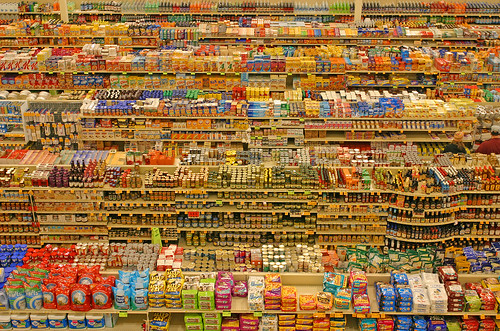
Shortly before Christmas, a new Tesco's opened in Carmarthen. It is allegedly the largest Tesco in West Wales... I hate it. I used to hate the huge one in Swansea, but this one really bites. What I hate about it most is the inhuman scale of the place, the only way I can describe it is to borrow a word from Watership Down - Tharn.
The first time I remember going tharn in a supermarket is the first time I visited the Safeway near B's old place in Portland. I stood in front of a dizzying array of 'hamburger helper' which seemed to stretch off as far as my eyes could see. What the hell was 'hamburger helper' and why did it need a whole aisle?
Anyway, this picture took me right back to that day in Portland.
If you are wondering why we shopping has become such an ordeal of endless choices, Malcolm Gadwell's Ted Talk might give you some insight as to why there are so many spaghetti sauces in the next aisle to all the hamburger helpers.
14 Jan 2007
new blog, new year, new resolve
Last week, I finally got around to contacting Business Eye, who have put me in touch with Venture Wales so that we can look at seeing if we can make a bit of money marketing Welsh companies to a very targeted, mostly American audience and Co-op Wales who they think might help me get the proposal off the ground in some sort of form. Fingers crossed.
11 Jan 2007
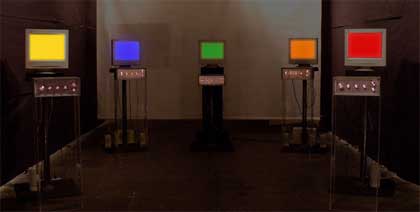 Instead of presenting complex images (computer programs or photographs) each computer of The Analog Color Field Computer (ACFC) repurposes its monitor such that a solid field of color is spread across its entire display. And instead of producing complex sounds (clicks, beeps or music) each sculpture produces a pure musical tone.
Instead of presenting complex images (computer programs or photographs) each computer of The Analog Color Field Computer (ACFC) repurposes its monitor such that a solid field of color is spread across its entire display. And instead of producing complex sounds (clicks, beeps or music) each sculpture produces a pure musical tone. By minimizing the content of its audio-visual renderings to solid colors and pure tones, the device offers relief from the myriad of visual, sonic and operational conventions traditionally associated with computer systems. The audience can adjust the hues, pitches and rhythms of each computer and thus assume a role previously reserved for a computer's video processor. They can manually regulate the electrical currents that command the monitor's color circuitry. The ACFC does not employ display systems as media for the visualization of computed images, instead the aesthetic artifact is derived from the physical manifestations and electrical workings of computer monitors themselves.
The piece also points to the rate at which Cathode Ray Tube based monitors are being discarded to leave the space to the much leaner flat panel displays. The ACFC gives the screens a new life as pieces of art. As a tribute to the CRT century-old technology, the installation utilizes analog electronics almost exclusively.
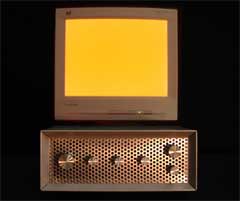
6 Jan 2007
seasonal readings
So, I want to tell you about 3 of the books that I have been reading over the last 3 weeks.
- Phillip Reeve, Mortal Engines. (I picked this up in a school library while I waited for an engineer to call me back. By the time he called back I was on chapter 4 and totally sucked in. I just had to buy it then. If you liked the Phillip Pullman, "His dark materials" trilogy, you might like this. Pretty gory for the age group it was designed for though.
- Sally Hacker, Doing it the Hard Way. One of my presents off B. It was a book that I used extensively in my MA dissertation and really wanted to read again.
- Moira Vincentelli, Women Potters. Great book, it examines women's pottery that has been pretty much ignored on a global basis. We are not talking about the fancy thrown and glazed stuff here, we are talking about hand built and bonfired. It also features interesting insights as to why a lot of the 'development' projects in pottery fail as well as a chapter on women's figurative ceramics.
"Never forget, Apprentices, that we Historians are the most important Guild in our city.We don't make as much money as the Merchants, but we create knowledge, which is worth a great deal more. We may not be responsible for steering London, like the Navigators, but where would the Navigators be if we hadn't preserved the ancient maps and charts? And as for the Guild of Engineers, just remember that every machine they have ever developed is based on some fragment of Old-Tech - ancient high technology that our museum keepers have perserved or our archaeologists have dug up."
"Bureaucratic organizations make responsible behaviour difficult. They tend to foster a "who cares?" attitude at lower levels of the organization and a "not me" attitude at the top (Gouldner 1976: Garson 1977). Those who chose engineering as a profession are likely to work in large bureaucratic organizations, but are less likely than most to have an interest in social structure or the complexities of social relations (Rossi 1975). Further, engineering education does little to increase students awareness of these phenomena. And so the engineer is oblivious to the ways in which he or she both affects and is affected by patterns and relations on the job.
If engineers do have a "blind spot" about social structure, altering current patterns and finding alternatives will be most difficult"
"As with all new technology, the introduction of water filters has to be accompanied by an education programme to ensure people understood how to use and maintain them properly.
There is a good argument for suggesting that it is more viable to build on the skills that are already in the community rather than seek radical change. It is particularly dangerous to make people dependent on technology that they cannot themselves produce, control or maintain. Self sufficiency is often assumed to be the aim but in fact projects can create dependency when equipment fails or followup expertise is not there."
Are we noticing any themes emerging?
dead as a DOPA
On the topic of Web 2.0 and education, a belated congrats to Miles Berry, who was awarded the Teacher: Primary award from BECTA this year. I regularly read his blog in Elgg and think he is doing a bang up job of using ICT creatively in his school and is a great advocate of Open Source software.

